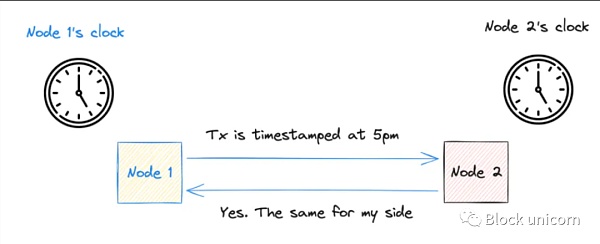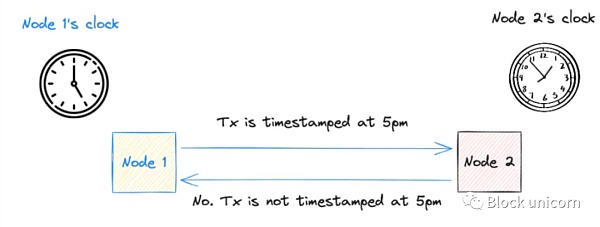Solana:委托权益证明(DPoS)和历史证明(PoH)
文章作者:Cookies Research
区块链的共识机制负责验证交易的有效性,并将它们按准确的顺序添加到区块链中。根据选择的共识机制,验证和排序过程的效率不同,从而导致不同水平的吞吐量。在区块链领域,Solana是一条高性能链,具有400毫秒的区块时间,每秒交易数(TPS)平均在2,000到3,000之间,理论上的峰值TPS为65,000(供参考,以太坊的TPS大约为12)。
本文旨在突出Solana中发挥关键作用、有助于其高吞吐量的两个架构,即其委托权益证明(DPoS)共识机制和历史证明(PoH)机制。
1. 传统共识机制
让我们从了解区块链的一个关键瓶颈开始:可拓展性。
分布式区块链网络中的每个节点都有自己的内部时钟,它按照这个本地系统时钟运行。当发生交易时,节点将根据这个本地系统时钟为交易添加时间戳。
下面图片是展示节点内部的时钟:

最终确认或拒绝交易的时间戳也将根据这个本地系统区块进行。在传统的共识机制(例如工作量证明PoW和权益证明PoS)中,所有的节点需要相互沟通,以协调彼此的本地时钟,以确保它们在处理交易时对时间的理解是一致的。节点之间的通信有助于建立一个共同的时间基准,以确保整个网络对时间的认知是一致的,从而协调交易的顺序和确认。

对于一个分布式区块链,有成千上万个节点分布在全球各地,节点之间的本地系统时钟存在差异是不可避免的,导致交易的时间戳在不同节点之间不一致。当节点需要就发生了哪些交易以及这些交易在区块中的顺序达成共识时,这就成为一个问题。这被称为时间戳同步问题,当网络通过增加节点数量来增强去中心化时,这个问题会变得更加严重和复杂。

最终,这为恶意攻击创造了一条可能的路径。时间上的差异使恶意行为者能够广播类似于真实时间戳的虚假交易,试图掌控网络。为防止对交易的操纵,需要花费大量的时间和处理能力来验证时间戳的准确性。这有可能导致区块确认的延迟,甚至区块被拒绝(因为节点可能投票认为区块无效,原因是具有不同的时间戳)。
2. 什么是历史证明(PoH)
历史证明(PoH)在Solana中用于证明交易被正确地按顺序排列,而这可以由网络中的验证者轻松验证。
与第一节提到的节点各自拥有其独立时钟的情况相反,PoH可以被视为一个全局块,所有节点都使用它来验证两个事件之间时间的流逝。通过这个全局时钟,节点查看相同的交易历史记录,摒弃了对交易顺序可能存在的任何分歧。这使得共识可以迅速达成,极大地缩短了交易被验证并添加到区块链的时间。
PoH依赖于一种加密方法,以创建交易的连续、按时间顺序的记录。让我们深入了解一下。
3. 对 PoH 的技术深入探讨
每个交易都经过 SHA-256 处理,这是一种以其能够接受任何输入并生成唯一、不可预测输出而闻名的加密哈希函数。当一个交易被哈希时,其输出成为下一个交易哈希的输入。这个过程在哈希输出中建立了交易的内置顺序,形成了一个长而连续的链。
PoH(历史证明)利用了可验证延迟函数(VDF),它在区块链中验证时间流逝的重要性。VDF是计算密集型的函数,不仅依赖于先前的哈希,还包含经过的时间。这个机制允许Solana以加密的方式展示真实时间已经过去,生成连续的输出。因此,存在清晰、可验证的交易顺序,确保了一致的事件时间轴。验证者因此可以轻松验证经过的时间有多长,进一步增强了网络的可信度。
在Solana中使用 PoH(历史证明)添加了一个强大的安全和完整性层。篡改哈希链的任何部分都会需要重新计算所有后续的哈希,这是一项努力密集型的工作,可保护网络免受更改的影响。
PoH(历史证明)显著减少了验证者每个区块需要处理的信息量。通过使用交易最新状态的哈希版本,区块确认时间被大幅缩短。当验证者(或复制节点)收到一个区块时,PoH(历史证明)序列为它们提供了一个具有加密可靠的交易顺序,他们可以在无需重新验证的情况下信任。这种效率对于加快共识机制至关重要,因为网络可以迅速选择并转移到下一个验证者进行区块验证。
4. 委托权益证明(DPoS)
在更好地了解 PoH 的基础上,本节将解释 PoH 如何在 Solana 的共识机制中(DPoS)得到应用。

在 DPoS 中,每个抵押了 $SOL 的验证者都能够参与网络治理——对区块的有效性进行投票,决定是否将其添加到区块链中。不愿直接参与权益证明过程的 $SOL 持有者(包括您和我)可以将其代币委托给其他验证者,从而有效地使它们成为委托人。这个委托过程将委托人的投票权(与他们拥有的 $SOL 数量成比例)分配给这些验证者。作为抵押 $SOL 的回报,委托人将获得区块奖励的一部分。
DPoS系统的运作原则是,具有较大权益的节点更有可能被选择来验证交易并将其添加到区块链中,获得区块奖励的机会鼓励节点保持高水平的性能和完整性。
在了解了DPoS和PoH两者之后,让我们将这些知识结合起来,概述一下在Solana上典型的区块确认是什么样的。
5. Solana 共识机制的高层概述
1. 领导节点的选择:领导节点负责生成 PoH 序列(历史证明排序交易)和创建区块。
这个选择过程是基于节点的权益权重的,这个权重通过代币持有人委托给它们而增加。领导角色将在验证者之间轮换。
2. 为交易添加时间戳:领导节点将接收交易,并使用 PoH 为它们添加时间戳,形成交易顺序。
3. 区块创建:通过来自 PoH 的序列,领导节点随后开始创建一个区块。
4. 区块传播:新创建的区块将被发送到复制节点(分布式网络中的其他验证者)。
5. 交易有效性验证,复制节点将验证以下两个组成部分:
a. 交易顺序:使用 PoH 序列验证交易是否按正确顺序排列。由于它是一个全局时钟,这种验证不需要节点之间的往返通信(与常见的共识机制如 PoW 和 PoS 不同)。
b. 交易有效性:检查交易是否符合网络规则并且有效。
6. 区块最终化:在验证了交易顺序和有效性之后,该区块将被添加到区块链中。然后将选择下一个领导节点,并且整个过程重新开始。
结论
Solana一直不懈努力改进其区块链架构,最近的发展包括QUIC、权益加权的QoS和本地化费用市场。此外,生态系统期待着通过Firedancer的推出显著提高其效率。值得关注的是,Solana独特的架构——OPOS(仅限Solana)可能会带来新的用例。
The consensus mechanism of the blockchain is responsible for verifying the validity of transactions and adding them to the blockchain in an accurate order. According to the selected consensus mechanism, the efficiency of the verification and sequencing process is different, which leads to different levels of throughput in the blockchain field. It is a high-performance chain with millisecond block time, and the average number of transactions per second is between and. The theoretical peak is for reference. This paper aims to highlight two architectures that contribute to its high throughput, namely its commission. The traditional consensus mechanism of equity proof and historical proof allows us to understand a key bottleneck of the blockchain. Each node in the scalable distributed blockchain network has its own internal clock, which runs according to this local system clock. When a transaction occurs, the node will add a time stamp to the transaction according to this local system clock. The picture below shows the clock inside the node, and the time stamp of the final confirmation or rejection of the transaction will also be carried out according to this local system block. In the consensus mechanism, such as workload proof and equity proof, all nodes need to communicate with each other to coordinate each other's local clocks to ensure that they have the same understanding of time when dealing with transactions. The communication between nodes helps to establish a common time reference to ensure that the whole network has the same understanding of time, so as to coordinate the order of transactions and confirm that there are differences in local system clocks among thousands of nodes distributed around the world for a distributed blockchain. Inevitably, the time stamps of transactions are inconsistent between different nodes. When nodes need to reach a consensus on which transactions have occurred and the order of these transactions in the block, this becomes a problem, which is called time stamp synchronization problem. When the network enhances decentralization by increasing the number of nodes, this problem will become more serious and complicated. Finally, this creates a possible path for malicious attacks. The difference in time enables malicious actors to broadcast falsehoods similar to real time stamps. In order to prevent the manipulation of transactions, it takes a lot of time and processing power to verify the accuracy of time stamps, which may lead to the delay of block confirmation or even the rejection of blocks, because nodes may vote that blocks are invalid because they have different time stamps. What is historical proof? Historical proof is used to prove that transactions are arranged correctly in order, which can be easily verified by the verifier in the network, and the nodes mentioned in the first section each have their own independent clocks. On the contrary, it can be regarded as a global block, which is used by all nodes to verify the passage of time between two events. Looking at the same transaction history through this global clock node abandons any differences that may exist in the transaction order, which enables a consensus to be reached quickly, greatly shortening the time for transactions to be verified and added to the blockchain, relying on an encryption method to create a continuous chronological record of transactions. Let's have a deep understanding of the right technology and discuss each transaction in depth. After processing, this is a cryptographic hash function which is famous for its ability to accept any input and generate a unique unpredictable output. When a transaction is hashed, its output becomes the input of the next transaction hash. This process establishes the built-in order of transactions in the hash output and forms a long and continuous chain. The history proves that the verifiable delay function is used to verify the importance of time lapse in the blockchain. It is a computationally intensive function that depends not only on the previous hash but also on the elapsed time. This mechanism allows to show that the real time has passed in an encrypted way to generate continuous output, so there is a clear and verifiable transaction order, which ensures a consistent event timeline verifier, so it can easily verify how long the elapsed time is, further enhancing the credibility of the network. Using historical proof in the process adds a strong security and integrity layer, and tampering with any part of the hash chain will require recalculation of all subsequent hashes, which is an effort-intensive work that can protect the network from The historical proof affected by the change significantly reduces the amount of information that the verifier needs to process in each block. By using the hash version of the latest transaction state, the block confirmation time is greatly shortened. When the verifier or replication node receives a block, the historical proof sequence provides them with an encrypted and reliable transaction sequence, and they can trust it without re-verification. This efficiency is very important for speeding up the consensus mechanism, because the network can quickly select and transfer to the next verifier. On the basis of a better understanding, this section will explain how to apply it in the consensus mechanism of the bank. Every mortgaged verifier can participate in network governance and vote on the validity of the block, and the holders who are unwilling to directly participate in the process of equity certification, including you and me, can entrust their tokens to other verifiers, thus effectively making them clients. The number is allocated to these verifiers in proportion as collateral. In return, the principal will get a part of the block reward. The operating principle of the system is that nodes with greater interests are more likely to be selected to verify the transaction and add it to the blockchain to get the opportunity of block reward, encouraging nodes to maintain a high level of performance and integrity. After understanding the two, let's combine these knowledge and summarize what a typical block confirmation mechanism is like in the world. The high-level overview of leading nodes. Selecting the leading node is responsible for generating sequence history proofs, sorting transactions and creating blocks. This selection process is based on the rights and interests of the nodes. This weight is entrusted to them by token holders, and the leading role will be increased. The verifiers will rotate to add time stamps to the transactions. The leading node will receive the transactions and use the time stamps to form transaction sequence block creation. The newly created blocks will be transmitted to the replication section by the sequence leading node from. Other verifiers in the point-distributed network verify the validity of transactions. The replication node will verify the following two components: the transaction sequence. The sequence is used to verify whether the transactions are arranged in the correct order. Because it is a global clock, this verification does not require round-trip communication between nodes and common consensus mechanisms, such as checking the validity of different transactions, whether the transactions conform to the network rules, and the effective block will eventually be added to the blockchain. After verifying the transaction sequence and validity, the next leader node will be selected and the whole process will be restarted. Conclusion We have been making unremitting efforts to improve its blockchain architecture recently. 比特币今日价格行情网_okx交易所app_永续合约_比特币怎么买卖交易_虚拟币交易所平台
注册有任何问题请添加 微信:MVIP619 拉你进入群

打开微信扫一扫
添加客服
进入交流群
1.本站遵循行业规范,任何转载的稿件都会明确标注作者和来源;2.本站的原创文章,请转载时务必注明文章作者和来源,不尊重原创的行为我们将追究责任;3.作者投稿可能会经我们编辑修改或补充。



















